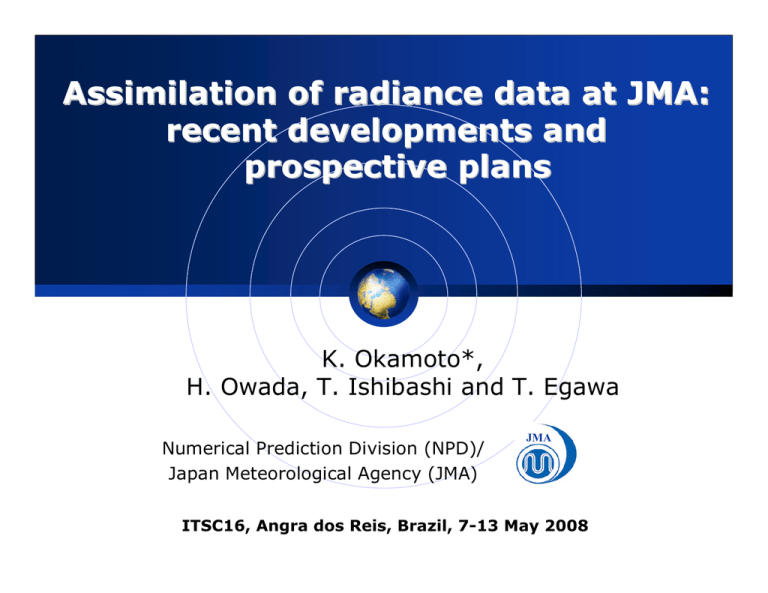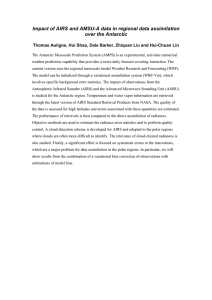Assimilation of radiance data at JMA: recent developments and prospective plans K. Okamoto*,
advertisement

Assimilation of radiance data at JMA: recent developments and prospective plans K. Okamoto*, H. Owada, T. Ishibashi and T. Egawa Numerical Prediction Division (NPD)/ Japan Meteorological Agency (JMA) JMA ITSC16, Angra dos Reis, Brazil, 7-13 May 2008 NWP models of JMA (Nov.2007~) JMA Model Global Model (GSM) Meso-scale Model (MSM) Resolution H/V(top height) TL959 (20km)/60(0.1hPa) *Before Nov.2007: TL319(60km)/40(0.4hPa) Forecast range (Initial time) 84h (00,06,18UTC) 216h (12UTC) 15h (00,06,12,18UTC) 33h (03,09,15,21UTC Target 1~7 day forecast Aeronautical forecast Disaster prevention information Data Assimilation (outer/inner loop) 4D-Var (TL959/T159 or 20km/80km) 4D-Var (10/20km) Window Length 6h 6h Radiance Assimilation RTTOV7, VarBC X (T/TCWV/rain retrieval) 5km/50 (21.8km) Satellite data assimilated JMA Sounders Radiance from NOAA15~18/AMSU-A,-B,MHS, Aqua/AMSU-A, Metop/AMSU-A,MHS in GDAS Including AP-RARS and EARS Temperature retrieval from NOAA15-18 and Metop/ATOVS in MDAS Microwave Radiometers (MWRs) Radiance from DMSP/SSMI, TRMM/TMI and Aqua/AMSR-E in GDAS Total Column Water Vapor (TCWV) and Rain Rate retrieval in MDAS Scatterometer Ocean surface wind vector from QuikSCAT/SeaWinds in GDAS & MDAS GPS-RO (Radio Occultation) Refractivity from CHAMP in GDAS AMV (Atmospheric Motion Vector) from Aqua+Terra/MODIS in GDAS GDAS GDAS::Global GlobalData DataAssimilation AssimilationSystem System MDAS : Meso-scale Data Assimilation Geostationary satellites MDAS : Meso-scale Data AssimilationSystem System AMV from MTSAT-1R, Meteosat7,9, GOES11,12 in GDAS & MDAS CSR (clear sky radiance) from MTSAT-1R in GDAS JMA MW window channel assimilation Operationally assimilate less cloud affected radiances of SSM/I, TMI and AMSR-E in GDAS since May 2006 Before BC After BC Before BC After BC V.Pol only VarBC test1: Improve QC and BC Stricter cloud screening & addition of total column cloud liquid water predictor in VarBC Small but consistent positive impact on the forecast of T850 test2: Add SSMIS+test1 19V, 22V, 37V, 92V Neutral impact from SSMIS window ch Time Timesequence sequenceof ofRMSE RMSEof ofday day11forecast forecast test1 test2 AIRS assimilation (ongoing development) Assimilate radiances 54ch/324ch over the sea Biases Biasesof ofAnalysis/firstAnalysis/firstguess verified guess verifiedagainst against radiosondes, Aug2007 radiosondes, Aug2007 Channel selection using Entropy Reduction TT[K] [K] (SH) (SH) (Rodgers 2000) Detect cloud-affected radiances based on McNally and Watts (2003) Comparison with CloudSat showed performance enough for QC (in poster) Bias correction scheme is the same as ATOVS except predictors in VarBC Tbobs, 1/cosθ, const Positive impact on analysis but neutral or negative on forecast reduces model biases of temperature and moisture. Anal (use AIRS) Anal (no AIRS) Guess (use AIRS) Guess (no AIRS) JMA Rh Rh[%] [%] (TRP) (TRP) AIRS radiance assimilation JMA Degrades forecast skills of the lower tropospheric temperature Possibely caused by the conflict of analysis increment with model trend Time Time sequence sequence of of RMSE RMSE of of 11- & & 5-day 5-day forecasts forecasts verified verified against against the the initials initials RMSE RMSEZ500 Z500 N.H. N.H. RMSE RMSET850 T850 Trp Trp Other topics on Poster 6.9 JMA Metop/ATOVS impact AP-RARS & EARS impact Clear Sky Radiances (CSRs) of WV-ch from geostationary satellites 1 geo vs. 5 geo AIRS radiance assimilation CloudSat comparison Plans End JMA Metop/AMSU-A & MHS assimilation JMA Assimilate radiances in GDAS Less cloud-affected, less land-surface-dependent radiances Implement a static scan-dependent Bias Correction (BC) and adaptive air-mass dependent BC Variational BC (VarBC) applied to air-mass BC Significantly positive impacts on forecasts, especially, of the geopotential height Moreover, great benefits of early and stable data dissemination Forecast ForecastImprovement ImprovementRate Ratewrt wrtRMSE RMSEfor for1-9 1-9day dayforecasts forecasts (cntl-test)/cntl test : using Metop, cntl : no Metop (cntl-test)/cntl test : using Metop, cntl : no Metop Psea T850 Z500 Statistically significant Wsp850 Wsp250 Better Worse Forecast hours 0 216 72 144 0 216 72 144 0 216 72 144 0 216 72 144 0 216 72 144 EARS impacts on forecasts JMA Forecast ForecastImprovement ImprovementRate Rate average averageover over6/11-7/6 6/11-7/62007 2007 Psea T850 Z500 Wsp850 Wsp250 Better Temperature Temperature improvement improvementrate rate FT=24 FT=24(left) (left)and and 120 (right) 120 (right) Worse Forecast hours JMA Geo. Sat. WVch CSR assimilation 5 Geo.Sat. WVch CSRs added Increase humidity in the mid- to upper troposphere, and even in the lower troposphere in dry areas Make analysis/guess closer to RAOB around 500hPa in RH and to AMSU-B&MHS channel 3 in TB Positive impact on forecast, especially at day 1 to 3 5 geo.sat. CSR assimilation has greater positive impact than one (MTSAT-1R) T850 Z500 1 1 satellite satellite Monthly Monthly averaged averaged TCWV TCWV diff. diff. by by WV-CSR WV-CSR assimilation assimilation Time Time sequence sequence of of TB TB O-B O-B STD STD 5 5 satellites satellites


